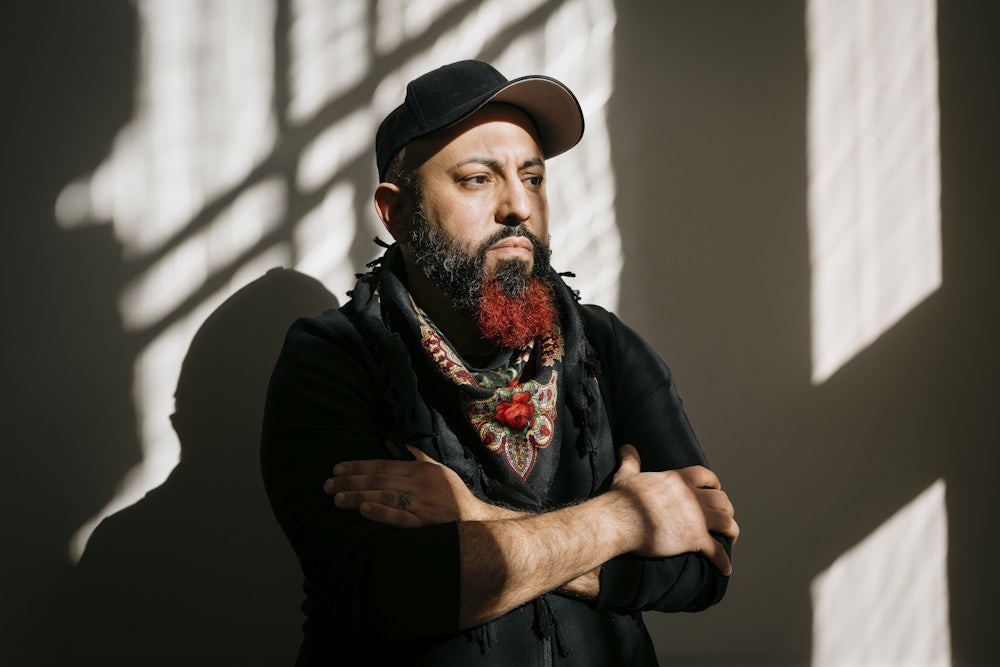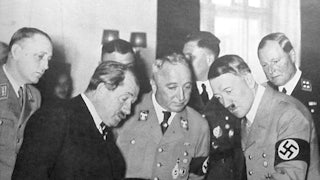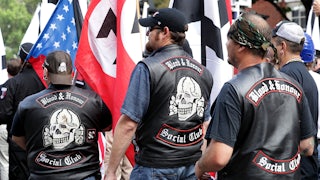Ferat Koçak barely made it out alive. At 3 a.m. one February night in 2018, while at his parents’ house in Berlin with his family, he woke up by chance. It was too bright for that time of night, he noticed. When he looked out the window, he saw that his car was engulfed in flames. He called the fire department and rushed his family out as the blaze from the car spread toward the building. Even before he received information from the police, Koçak, a German of Kurdish descent with a long beard dyed in the anti-fascist colors of black and red, was certain what had happened: He was being targeted by the far right for his anti-racist, anti-fascist activism.
“If we got out five minutes later, we would have died,” Koçak told me, stone-faced and wearing all black. A Google Images search of him later revealed that this ensemble—paired with Adidas Sambas and occasionally a cap and scarf—is his typical look. He had told the story of that night to German media countless times, but, understandably, he wasn’t over it. In German fashion, he spoke calmly and deliberately. We were sitting in the office common room of Die Linke, or the Left Party, just off a leafy cobblestone street in Neukölln, the neighborhood where Koçak lives and where, five years ago, he was attacked. It’s a neighborhood that’s important to him. His Twitter handle is “der_neukoellner”; until recently, he also went by this name on the encrypted messaging app Signal.
A year after the attack, in March, Berlin’s Criminal Investigation Department received an anonymous email that seemed to confirm Koçak’s suspicions. The emailer, who took credit for the arson, claimed to be a member of NSU 2.0—a revived version of the National Socialist Underground, a neo-Nazi group responsible for at least 10 murders between 2000 and 2007. Koçak was the perfect choice for a neo-Nazi: He is an ethnic minority who is also a vocal anti-racist activist; he is a left-wing politician, and, thanks to his red and black beard, he is a solo, walking anti-fascist demonstration. He took the fire as a warning to get him to stop his political work and activism, and, after his mother had a heart attack in the days following the fire, he almost did. “My mom told me, ‘No, you can’t,’” Koçak recalled. “‘They want this, so you should do the opposite.’”
The broad sweep of Western history usually gets recounted something like this: In the economic turmoil that followed World War I, fascism rose in Weimar Germany, Hitler surged to power, and Churchill and Roosevelt swooped in to save the day. The victorious Allies quickly de-Nazified the country, and while it suffered during the Cold War split between East and West, its fascist past was truly the past. But in actuality, after World War II, neo-Nazi attacks and organizing never fully abated. Indeed, it became much more visible after the fall of the Berlin Wall and the reunification of East and West Germany in 1990. Since the ’90s, Germany’s neo-Nazi resurgence has gone through ebbs and flows. Most recently, it gathered momentum in 2015 and 2016, following an uptick in immigrants fleeing a civil war in Syria.
And while the national government in Germany is run by a center-left coalition, in recent years there’s been a groundswell of support for the far right. Alternative für Deutschland, or AfD—which might best be described as a far-, far-right party—now holds more than 10 percent of seats in the national Parliament, and even greater sway in local municipalities in the old Soviet, eastern parts of the country, where support for the far right is strongest. The trend is a warning sign for the rest of Europe, and an immediate concern for Germans. Not only has the right’s rise triggered collective apprehension about the same threats to democratic norms that have plagued countries across the West in recent years, it’s also translated into increased threats of violence. The rise of the right and the uptick in violence cannot be detached from the relatively generous stance toward immigration that Germany has taken compared to other European countries. In absolute numbers, it has accepted more refugees than any country in Europe besides Turkey: 2.2 million as of 2022. Between 2012 and 2021, in terms of refugees as a proportion of total population, Germany ranked fifth, behind Turkey, Sweden, Greece, and Malta. As a matter of national policy, Germany has, with the best intentions, dispersed asylum seekers and other immigrants throughout the country. But these seemingly well-intentioned policies have created dangerous situations where people of color are forced to reside in regions that may be hostile to their presence, and where they face greater threats from neo-Nazis and fascists.
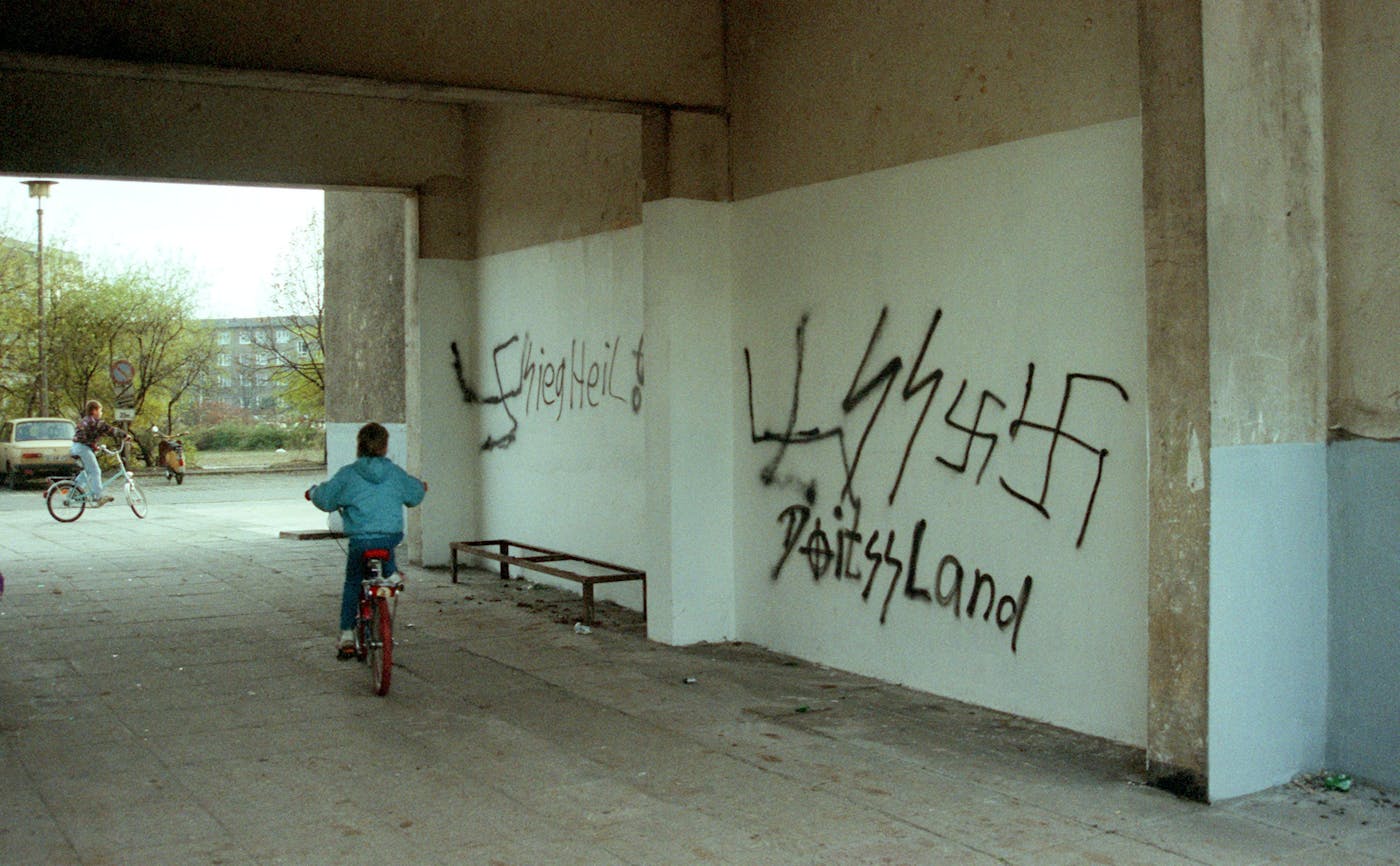
Many of the attacks have occurred in smaller rural towns, and occasionally in eastern cities such as Chemnitz and Dresden. But they’ve also crept into Germany’s largest, most cosmopolitan city, which puts forward an image of international multiculturalism. And for roughly the past decade, a small but persistent stream of attacks has hit Berlin’s trendiest neighborhood, Neukölln. Estimates vary, but since 2016, police have investigated more than 70 attacks in Neukölln linked to the far right, ranging from arson to bricks thrown through windows to graffitied death threats. The German newspaper taz noted in 2019 that all of the attacks have been directed at activists, like Koçak, who organize against the far right.
In some ways, the Neukölln attacks are a contradiction. The neighborhood is among the most diverse in the city. Middle Eastern and Vietnamese restaurants line the streets between pockets of cafés and bars frequented by the city’s creative class of artists, DJs, and young people who want to associate with that milieu. For comparison, neo-Nazis roaming Neukölln might be akin to a right-wing paramilitary cell maintaining an organized presence in demographically diverse artist havens like Bushwick, Brooklyn, or Echo Park, Los Angeles.
That said, if the neighborhood is diverse by German standards, it is nevertheless predominately and historically white. Koçak believes that the violence is a racist reaction to recent demographic shifts. Rising rents in Berlin’s bohemian former punk hub, Kreuzberg, have pushed younger, white German creatives into North Neukölln, displacing that neighborhood’s immigrant population further south. “South Neukölln is not like North Neukölln. It’s more white, more German,” Koçak said. “The gentrification in the north changed the population in the south. This was one reason they started the attacks.”
Investigative reporting by Berliner Morgenpost and the public broadcaster RBB eventually alerted Koçak that NSU 2.0 had made a second threat against him, but he was never notified by the police. It’s unclear why, and the failure underscores a problem he and many others describe: It is difficult to trust the police, because some of them are dismissive of far-right violence, and some even belong to the far right.
The arson attack Koçak endured was not just a microcosm of something happening in Neukölln or Berlin at large. It represents a phenomenon occurring across the entire country. In 2021, far-right crimes reached a record high of 24,000; attacks on refugee shelters increased by 73 percent between 2021 and 2022. And even asylum seekers who avoid violence in Germany must still face difficult living conditions and years of isolation trapped in inhospitable small towns, stuck in asylum limbo. As the far right and the neo-Nazi movement it harbors burgeon in Germany, refugees, asylum seekers, and people of color are paying the price.
“No-go zone” is a politically charged term. If you’re familiar with it, you probably first heard about it sometime between 2015 and 2018, when conservatives in the United States and Europe used it to refer to neighborhoods in European cities “where Sharia courts are set up, where Muslim density is very intense, where police don’t go in,” as one Fox News guest said in a 2015 segment for which the network later issued an apology and correction.
That use of the term—to describe enclaves where immigrants have established some kind of hegemony—is in fact the exact opposite of how it was originally defined by right-wing extremists, who envisioned “national liberated zones” where “the only figures of rule or the enforcement of order” were the extremists themselves, usually neo-Nazis, wrote Lukáš Novotný, a professor at Jan Evangelista Purkyně University in the Czech Republic, in a 2009 paper. “They are zones to which foreigners have limited (or no) access.”
Novotný traces the history of far-right extremists’ no-go zone aspirations in Germany back to the ’90s, decades before conservatives popularized their own version of the term. In the neo-Nazis’ fantasy of such an area, the local government, law enforcement, and the population either have enough neo-Nazis in their ranks to enforce the boundaries of the no-go zone or contain a critical mass of sympathetic locals who turn a blind eye to the violence used.
This conception is a grim neo-Nazi pipe dream. But evidence suggests that something resembling the no-go zone has existed in parts of Germany. A 2007 report conducted by the Office for the Protection of the Constitutional Order in the German state of Brandenburg counted 17 of what it called “fear zones.” According to Novotný, the report describes the areas as “zones where extremists have managed to cut out all other groups from participating in social life,” and where the far right has “excluded other (non-neo-Nazi) groups from participating in or attending any cultural or other activities.”
Among Germans I spoke to, the term sparked a complicated reaction. They didn’t want to lend credence to the idea that neo-Nazis had gained enough power to determine who gets to travel in and out of some areas; in a certain way, to do so would be to shore up neo-Nazis’ story of their own success. But they were also reluctant to totally deny the existence of such regions. The fact that people of color often live in or near areas that could be considered no-go zones makes discerning the boundaries of these areas even more challenging.
Johannes Kiess, a professor of sociology at the University of Siegen in Germany who studies right-wing extremism and its impacts, summed up this tension. Take the town of Bautzen, known as a rural right-wing stronghold in eastern Germany. “I don’t reinforce the right-wing narrative that there’s a no-go area in a town like Bautzen,” Kiess said, because “that’s exactly what they want.” What’s more, although there is a strong far-right presence, neo-Nazis “are not everywhere.” At the same time, he explained, “I would never say to a Black person, ‘Why are you afraid? Just go and stand your ground.’”
Different people also experience different Germanys. “They know me, and they see my beard,” Koçak explained. Whereas I and other people of color take trains freely around the country, for Koçak, many nonurban areas feel off-limits. “A friend of mine wanted to go to Leipzig, but I told them I don’t want to, because there are a lot of areas between Leipzig and Berlin where Nazis live.”
You might think that a vocal anti-racist fearing to set foot in an area would mean that people of color generally don’t live there. This isn’t the case. Across the country live a small but noticeable number of asylum seekers, even in rural locales in the east that—both historically and still to this day—have been hostile to outsiders and minorities. Indeed, the German government mandates this distribution, sending asylum seekers to different regions according to quotas calculated by tax receipts and population numbers.
Though support for the far right and related violence can be found around the entire country, it is most severe in eastern states, especially Saxony. In 2018, the Saxon city Chemnitz hosted a far-right mass demonstration that turned violent. In 2015, a similar situation played out in nearby Leipzig. Voters in the east, more than in other regions, tend to support the AfD, which was founded in 2013 by economists and professors as a right-wing, populist response to German-backed bailouts for economically ailing Southern European countries. The AfD has scored its biggest electoral successes in Saxony, where it holds 36 of the 119 seats in the state Parliament, second only to the center-right Christian Democratic Union, or CDU. It is also the second-most-represented party in the eastern German states of Brandenburg, Saxony-Anhalt, Mecklenburg-Vorpommern, and Thuringia.
While it was founded as a conservative party, by 2016 AfD had made a hard-right turn, taken over by an insurgent internal wing that established a firmly antisemitic, anti-immigrant tone.
Nevertheless, the AfD has aggressively disputed claims that it is fascist or neo-Nazi. And if some of its base is not, many of its members are routinely revealed as neo-Nazis. The party’s ascendance almost perfectly coincides with a decline in support for Germany’s overtly neo-Nazi party, the National Democratic Party of Germany, or NPD. In 2018, the German publication Die Zeit found that at least 27 staffers working for AfD politicians had links to the NPD and other neo-Nazi groups. Last year, AfD lost a legal challenge against the country’s intelligence agency, which had decided to monitor communications among AfD members. “We know from German history that far-right extremism didn’t just destroy human lives, it destroyed democracy,” the head of German intelligence said in 2020. “Far-right extremism and far-right terrorism are currently the biggest danger for democracy in Germany.”
The German reunification process was a flash point for the ascent of German neo-Nazis. One of the highest-profile attacks happened in 1991 in Hoyerswerda, a rural town in Saxony, where neo-Nazis invaded buildings where Vietnamese and Mozambican workers were living, an onslaught that eventually escalated into a full riot. In the middle of the night, 230 foreigners had to be bused to a nearby army base for their safety. Violence to that degree hasn’t recurred in Hoyerswerda since 1991, but in 2006 the youth wing of the NPD held a commemorative demonstration.
Neo-Nazis carried out other attacks across the country at around the same time as the Hoyerswerda riots, and the German government’s reaction was troubling. It “wasn’t to protect these refugees,” said Dave Schmidtke, the spokesperson for Sächsischer Flüchtlingsrat e.V., or Saxon Refugee Council, an NGO that advocates for refugees and asylum seekers in Saxony. The government’s primary concern during that era, in Schmidtke’s view, was that refugees were endangering “the social peace.” So, it decided, “we have to get rid of these refugees.” Following World War II, West Germany’s stated policy was to grant asylum widely and, by contemporary standards, to welcome immigrants. After reunification, the same policy was applied in the East, which did not take kindly to the change. In 1993, asylum restrictions became significantly stricter, the result of an amendment to Germany’s Basic Law that limited who is eligible.
After 2015, when refugees fleeing Syria arrived en masse in Europe, a new wave of attacks rippled across Germany. In 2016, a mob went after refugees in Bautzen. In 2019, a politician who spoke out against the anti-immigrant far right was assassinated by a right-wing extremist. And in 2020, a far-right extremist went on a shooting spree that killed 11 people in the western German town of Hanau.
I wanted to see one of the far-right enclaves in the east for myself, to get a better sense of the difficulty immigrants face there. Two people had killed themselves in recent months because they had no prospect of staying in Germany, Schmidtke told me from the driver’s seat of a hatchback rental car. They were going to be sent back to war zones. We were on our way to Hoyerswerda, where the infamous 1991 attack on Vietnamese and Mozambican workers occurred, and which today is home to a small refugee camp. The verdant trees and rolling grassy hills we passed looked identical to the interior of the mid-Atlantic near Appalachia, where Virginia bleeds into West Virginia. Symmetrically, this German state, one ocean and several countries over, is facing economic and deindustrialization problems similar to those that have ravaged Appalachia. Unlike Appalachia, the area has become a hub for neo-Nazis.
When Hoyerswerda officials announced plans to open refugee housing in 2014, a local preacher told Der Spiegel that the camp would be a chance to “show Hoyerswerda’s better face,” and attributed the violence decades before to the “considerable turmoil after the Berlin Wall fell.” Yet poor treatment of foreigners in the town hasn’t gone away. It’s just taken a different form. Asylum seekers still face abuse from racists in the general population. But, perhaps more insidiously, they also suffer abuse from the government.
Schmidtke was on his way to a weekly meeting for female asylum seekers who had been placed in Hoyerswerda. Many, Schmidtke told me, had been stuck in asylum purgatory, where they lived in what he referred to as a “camp”—crowded, dorm-style living quarters in which multiple families are packed on each floor, all sharing limited bathrooms, kitchen, and general living space. The recurring meeting was set up by a local civil organization as a space for the women to gather with one another, and sometimes to speak with local volunteers and social workers such as Schmidtke. But it was as much a refuge for the women away from their cramped living quarters, a place to commiserate over coffee and pastries.
Hoyerswerda is not particularly picturesque—there is little charming Bavarian architecture and few of the quaint old churches we usually associate with small German towns. True to East German Soviet form, the buildings tend to be simple, without ornate facades. They are designed for efficiency. After driving through the edge of town, we arrived at an old, run-down Soviet-era youth center.
Headed into that day, I’d worried that the refugees might be apprehensive about talking to a journalist, out of fear of jeopardizing their asylum status. To a degree, they were—the names by which I refer to them here are pseudonyms—but most were eager, and in some cases desperate, for the chance to speak, in the hopes that someone out there might be able to do something to make their lives less harsh.
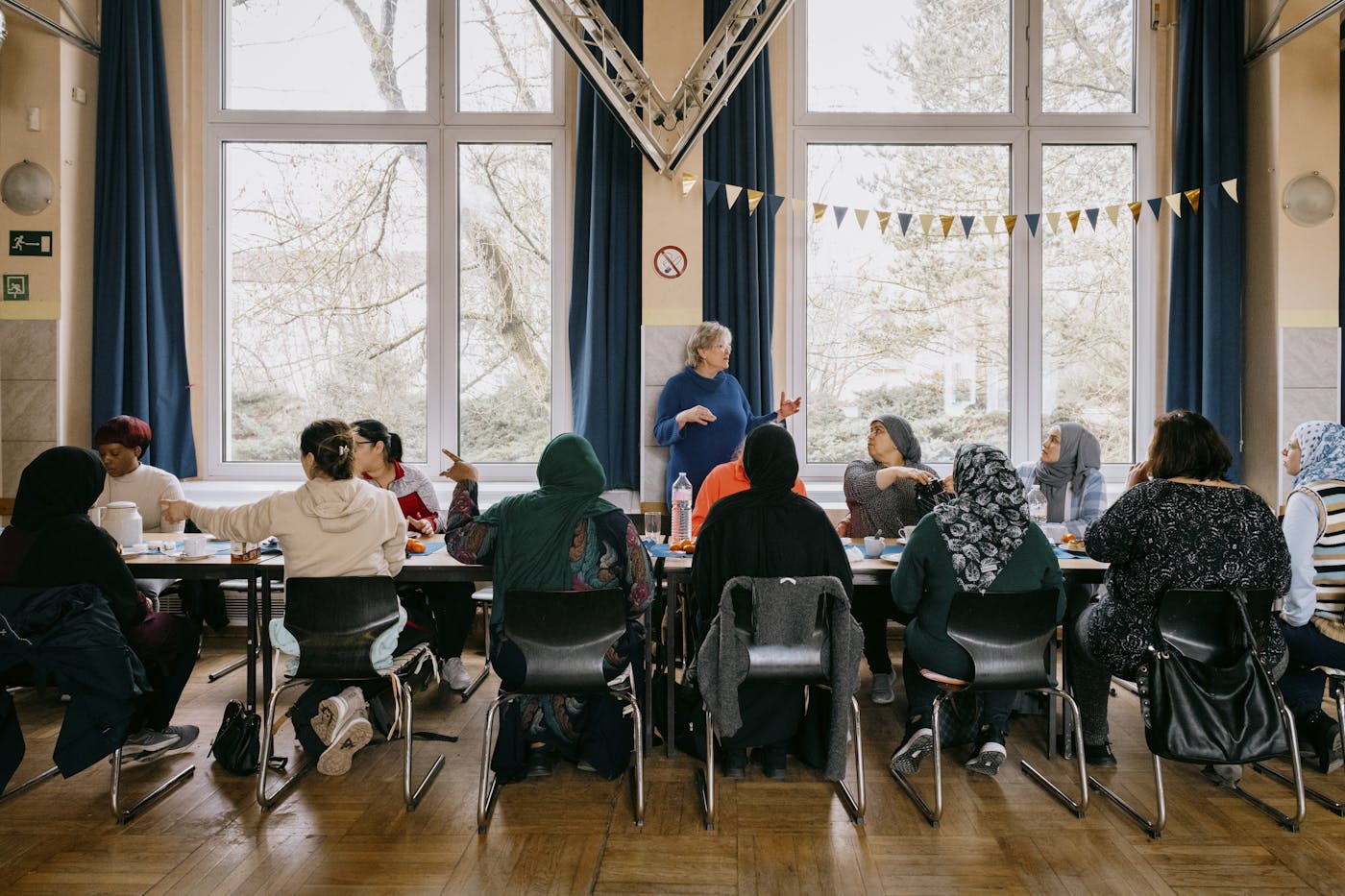
Among the two dozen or so women at the meeting, two felt comfortable enough with their English to speak to me: Isha from Pakistan and Samina from India. Both had lived in the camp for years, and their asylum status had been stuck in indefinite limbo for more than half a decade. Isha recalled the hostility she faced in Hoyerswerda before she even made it inside the camp. She wasn’t sure where to get off the bus and asked the driver if he could help. He told her to “speak Deutsch” and get her kids off his bus.
Things didn’t improve much inside the camp. “My kids say to me, ‘Mama, our life is like a punishment,’” Isha told me. “We live like prisoners.” She and her children share a single room, which she and the other asylum seekers refer to as the “Heim,” German for home. The camp is a former school that was converted into refugee housing in 2014, the first “refugee hostel” (as Der Spiegel termed it) in Hoyerswerda since the attacks in 1991.
Though Isha and Samina said that they felt on edge around Germans in Hoyerswerda—people are often cold, and sometimes outright antagonistic—the bulk of their tribulations has come from Saxony’s government. Indeed, aspects of the asylum process that Schmidtke, Isha, and Samina recounted sounded more like a sadist’s fantasy vision of a Kafkaesque bureaucracy than rational immigration policy. While most people in the camp are stuck in asylum limbo—not deported but also not granted residency status or sometimes even the ability to leave—a few occasionally choose another option: the hardship commission. But this path is like making a double-or-nothing bet with your immigration status. The hardship commission is widely considered a last hope for appeal. The Ministry of the Interior and Sports of Lower Saxony found that, in its state, the rejection rate for hardship cases averaged 43 percent between 2016 and 2020. It’s possible this number is higher in states, such as Saxony, that are more hostile to immigrants.
For those who opt out of the hardship commission route, their passport becomes effectively meaningless. Asylum seekers whose applications are denied, but for whom deportation is not feasible, receive a state-issued document commonly known as a Duldung, or tolerated stay.
The ID has a large red line across it signifying “a temporary suspension of deportation,” which means, Samina explained, that while its holders get to stay in Germany, they can’t leave Saxony. Isha pulled hers out to show me.
A psychologist had told Isha that one of her kids was experiencing psychological problems, exacerbated by the cramped quarters and complete lack of privacy. Samina said that she believes almost half of the population in the camp is dealing with such problems. While I couldn’t verify this number, a 2005 study on Iraqi asylum seekers in the Netherlands suggests that migrants in a “long asylum procedure,” like those in the Hoyerswerda campus, experience significant negative mental health outcomes.
A 2017 paper—straightforwardly titled “‘It’s Like Fighting for Survival’: How Rejected Black African Asylum Seekers Experience Living Conditions in an Eastern German State”—found that eastern Germany consistently forces refugees to endure abysmal accommodations. Twelve Black Africans living in refugee accommodations in an unspecified eastern state described similar situations to the Hoyerswerda camp: stuck in their camps for years at a time, in cramped, unsanitary living quarters, sharing a single room with as many as six others and sharing a stove and a single bathroom with many more.
Isha’s husband was not granted the same asylum-seeking status she was and was barred from entering the country. He told her and the kids to go without him. “They always talk about father. ‘Mama, when will Papa come here?’” For most of our conversation, Isha had been frustrated but resolute. But an hour into talking, she started to cry. “My husband has applied to come here so many times, but they always reject, reject, reject. My kids are big now. So much time has passed,” she said, stopping to sniffle and catch her breath. “I only have hope.”
Isha was only one of multiple women who broke down in front of me as they recounted their time at the camp. After I spoke with her and Samina, a Somali asylum seeker approached me. She didn’t speak English but was undeterred. Schmidtke was busy, so I pulled up Google Translate on my phone, translated “What do you want to talk about?” into Somalian, and handed it to her.
“I am a single mother. I have a little boy here who is sick,” the translation of Somalian read when she handed it back. “I have diabetes and high blood pressure.” Typing messages in Google Translate was a strained way to hold a conversation, but we continued for almost an hour. She was facing the same problems as Samina and Isha: cramped quarters and declining health. At times, the conversation was difficult to follow, and I told her that, as a foreign journalist, I could basically do nothing to help her, as much as I wanted to in that moment. But she kept typing messages to me, desperately and persistently, tearing up as she clicked at my phone.
As Schmidtke and I got up to leave, she pleaded with him for help in German. Later, in the car on the way back, he told me that she had said she might kill herself if things didn’t get better soon. One of the two suicides Schmidtke had told me about was a 53-year-old Pakistani man who was denied both asylum and the ability to return to Pakistan as his health deteriorated. He jumped from a window in the building.
“You have a hard job,” I said to Schmidtke as we walked out of the center.
“I don’t allow myself to think that, because a lot of people actually have to live it,” he said. “When I go to the camp, and it smells and is loud, I know that I’m just there for a couple of hours. I don’t have to live like they do.” Schmidtke paused for a second to consider what he’d said. It was hard, he went on, not to be able to help people more. “That’s why a lot of people quit this job after a couple of years.”
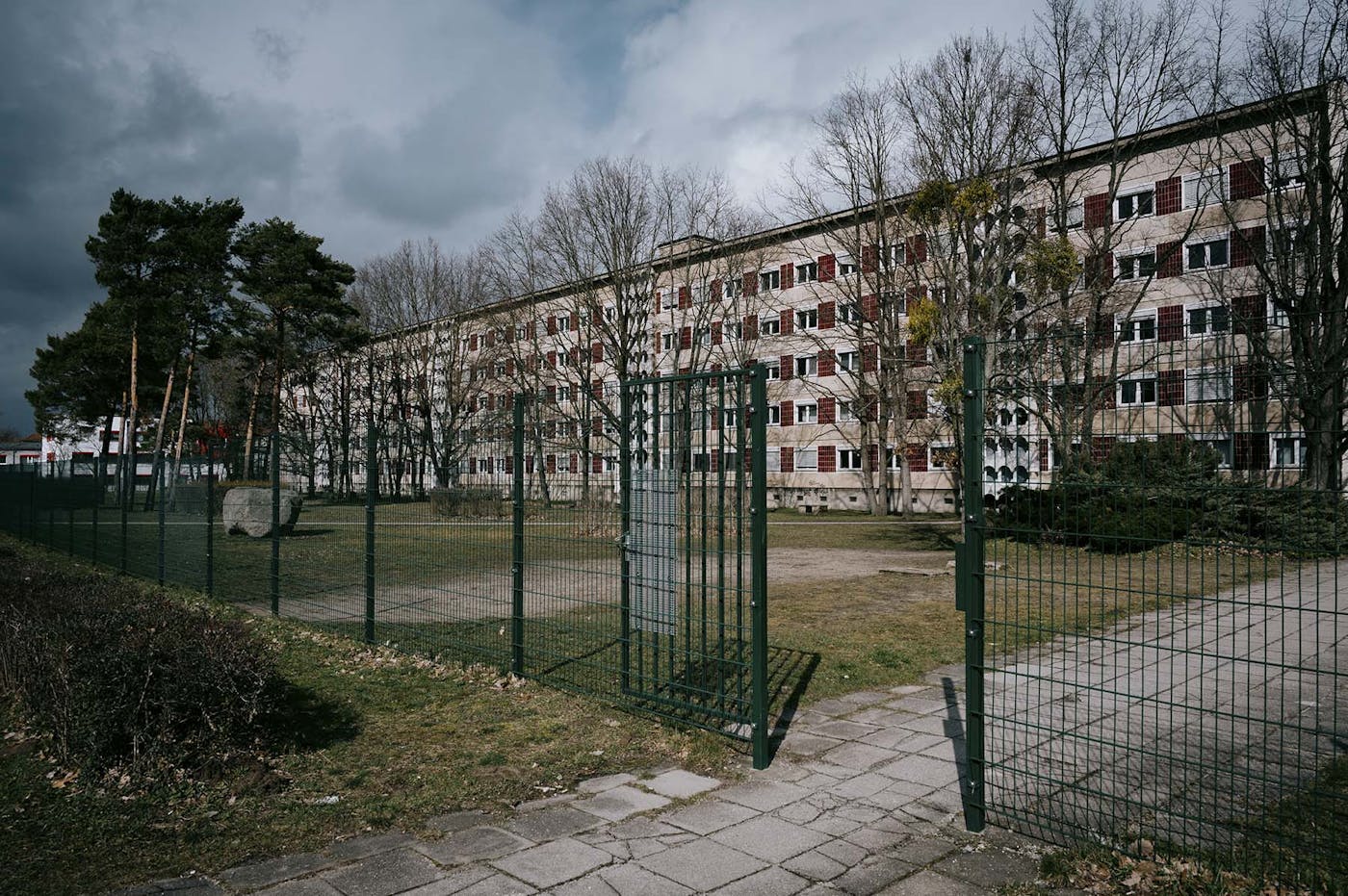
The conditions in Saxony aren’t just the result of bureaucracy. Schmidtke and other activists and experts believe that they’re linked to the ascent of the far right and the racism that’s endemic in eastern Germany. Since the Berlin Wall fell, far-right attacks and the rise of far-right parties that court neo-Nazis have coincided with increasingly hostile immigration policy. With the exception of Berlin, eastern states have a considerably lower population of Germans with a migrant background than the rest of the country.
Migrants who do end up in eastern Germany often suffer under harsher conditions than those in the west. This is the result of policy decisions that far-right local governments make, but can also be chalked up to centrist parties trying to stave off right-wing insurgent challenges—as well as bureaucrats who may harbor far-right-wing sympathies. As Penny Bochum observed in her 2020 book on the rise of the AfD, We Are the People, when Annegret Kramp-Karrenbauer became leader of the centrist party the Christian Democratic Union after barely beating a far-right opponent in 2018, she purposefully made overtures to the right, calling for “increased security on EU borders—as well as measures to ‘make Islam compatible with the European way of life.’” In 2021, Kramp-Karrenbauer stepped down as leader of the CDU, in protest of the party voting with the AfD in Thuringia. But other centrist party leaders have tried to make even more aggressive anti-immigration, Islamophobic overtures.
Schmidtke said that he and his peers at other NGOs believe immigration officers in Saxony are intentionally looking for mistakes in order to reject asylum cases. Officials “have space for individual decisions,” he explained, which they can use to make life harder for refugees if they’re so inclined. And if a refugee or asylum seeker is led astray, there’s little opportunity for recourse. Schmidtke recalled speaking with a Nigerian immigrant who was told by an immigration officer—inaccurately—that he had no shot at asylum, and “should get back to Nigeria as fast as possible.” Data suggests Schmidtke’s story isn’t just a one-off anecdote. In eastern German cities and towns, including Dresden and Chemnitz, approval of asylum requests is significantly lower than the nation’s average.
In some cases, the discrimination is even more explicit. Robert Kusche, the managing director of RAA Sachsen e.V., a nonprofit group focused on tracking the rise of right-wing extremism in Saxony, explained that he’s frequently observed immigration officials singling out minorities. Dresden, where his nonprofit is based, sits on a major railroad route for refugees coming out of Ukraine. On the trains, Kusche said, police usually check only the documentation of Black people, “despite the fact that there are a lot of other refugees on the train,” not least Ukrainians fleeing the war.
Asylum seekers who do stay in Germany are met with increasingly difficult conditions. In response to a 2019 amendment that extended the period (from 15 to 18 months) during which asylum seekers were prevented from accessing health care except in instances of “acute diseases or pain,” several states enacted policies to reduce barriers to asylum seekers’ access to health care. The eastern states of Saxony and Mecklenburg-Vorpommern, however, do not provide this kind of carve-out.
In a way, the asylum seekers I met had won an immigration lottery by being allowed into Germany in the first place. But even though this might have been true on paper, those I spoke to didn’t feel lucky. “It was not a good decision to come here,” Isha told me, crying. Still, she felt she had no choice. “I have nothing in Pakistan. How can I go back?”
In 2018, when the AfD held a rally in Berlin, the party’s 5,000 supporters were drowned out by 25,000 counterprotesters. People with whom I spoke in Germany expected an AfD rally scheduled for the first weekend in October last year to go similarly.
But something a little different came to pass. For the first time since the AfD’s rise over the last 10 years, supporters in Berlin outnumbered counterprotesters. Koçak and I were both at the rally but didn’t see each other. He was delivering speeches at counterprotests; I observed near the Reichstag, Germany’s Parliament building, where AfD supporters gathered before marching through the city. Berlin police had set up barriers to keep counterprotesters from entering the AfD protest area, a strategy that seemed to bank on Germans’ willingness to be compliant—I was let in with only the scrutiny of a small glance and no check of my journalist credentials.
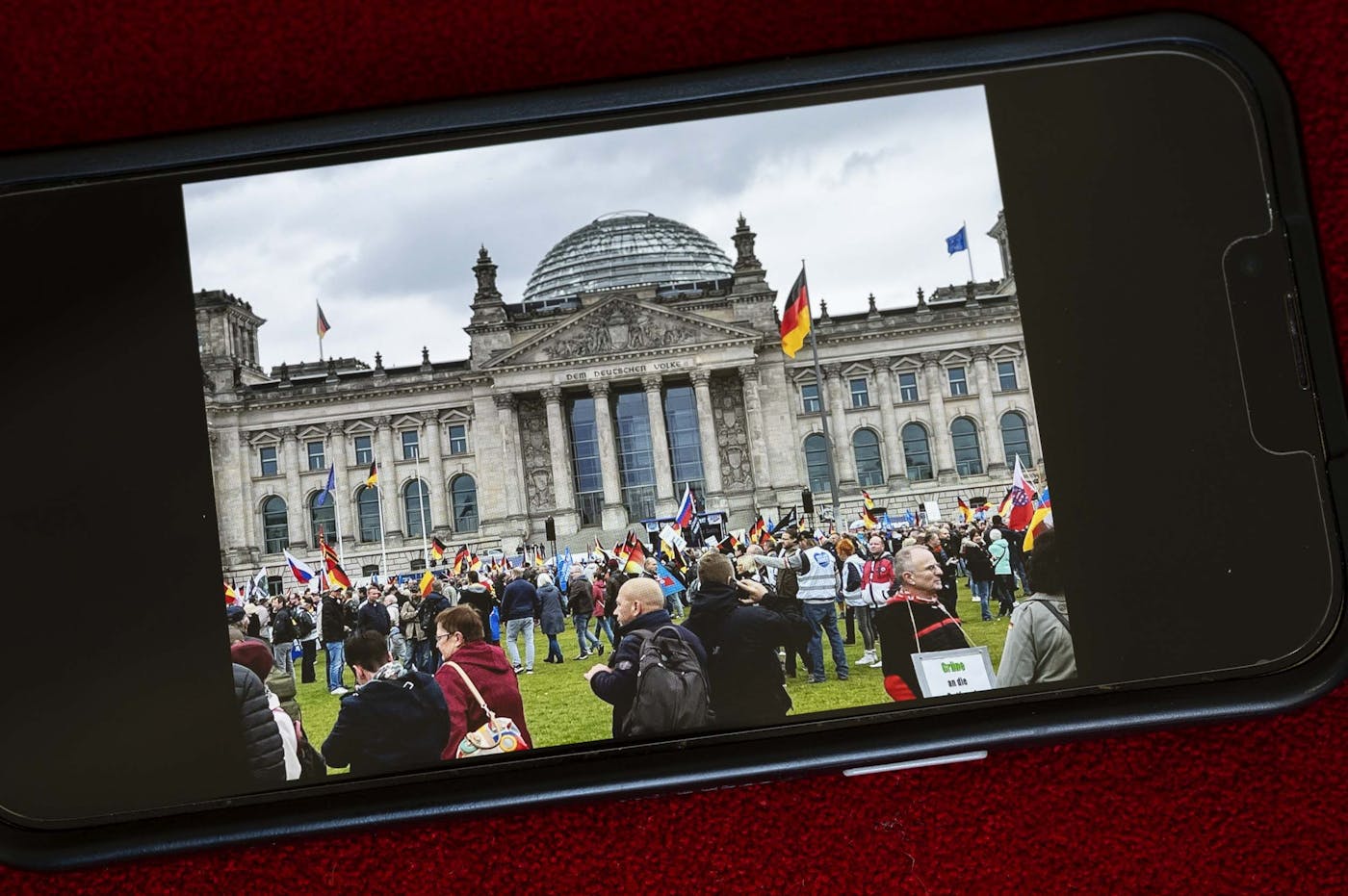
At the rally, thousands of AfD supporters looked on at a small stage just in front of the Reichstag. German flags stuck up above the crowd. A smaller number of people waved flags for the AfD stronghold states of Thuringia and Saxony. A noticeable number also held up Russian flags. Less fashionable and more conventional than typical Berliners, the people in the crowd looked something like those I was used to seeing in suburban Texas.
I wandered around trying to speak to rallygoers, but was met with a dour and suspicious “Nein” every time I asked if they spoke English and were willing to answer questions—unusual for Berlin, where more than half the population speaks English, often fluently. I was the only person of color I could see as I walked from group to group, though Koçak later told me he was surprised to see a few people of color in the part of the rally where he was.
Although everyone I tried to speak with was nice enough besides their terseness, after 20 minutes, my self-preservation instinct kicked in. I stuck out like a sore thumb. I headed to a back corner of the rally, where some other journalists I knew had stationed themselves.
“The speaker just told the crowd to not attack journalists,” said Kate Brady, a Berlin-based reporter who now works for The Washington Post, after I found my way to her and a mutual friend. As I learned later, a German journalist tweeted that a camera team had been attacked at the rally and some of their equipment damaged. Unaware of that violence at the moment, Brady, fluent in German, translated the broad strokes of the speeches, in which AfD party leaders riffed about how immigrants were responsible for many of Germany’s problems and demanded that Germany lift sanctions on Russia to bring the surging price of energy down. Members of Young Alternative—the youth wing of the AfD—were in attendance.
During the miles-long march afterward, police, some of whom had been brought in from other states to support Berlin’s force, helped make sure that every possible entry point was blocked off by a security checkpoint. As we walked, the scene grew surreal. Unter den Linden, an enormous, tree-lined boulevard that leads to the Brandenburg Gate—the eighteenth-century monument that abutted the Berlin Wall during the Cold War and became a symbol of unity and a tourist destination after—was completely closed off. For more than a quarter-mile, both sides of the multilane street were AfD territory. AfD propaganda littered the ground. AfD supporters sat on café patios wearing small AfD hearts emblazoned with one of the party’s slogans, UNSER LAND ZUERST!: Our country first.
A week later, when Koçak and I talked about the rally, he sounded tired. They had been fighting for years, and the momentum that had brought 25,000 counterprotesters to the AfD’s last Berlin rally, in 2018, was flagging. “The problem was not 10,000 people on the streets for the AfD,” he explained. “The problem was that … there were only 2,000 anti-fascists. That is not enough.” Koçak was concerned that the numbers suggested that AfD was on its way to being accepted as normal—not supported by the vast majority of Berliners, but nevertheless understood as an inevitable political reality. “If the left does not find answers and will not mobilize protests on the streets, then the AfD will get stronger,” Koçak said. “We are in a moment of change. It’s an economically hard time, like it was in the 1930s. And in Germany we have this saying, ‘Geschichte wiederholt sich’”: History repeats itself.
